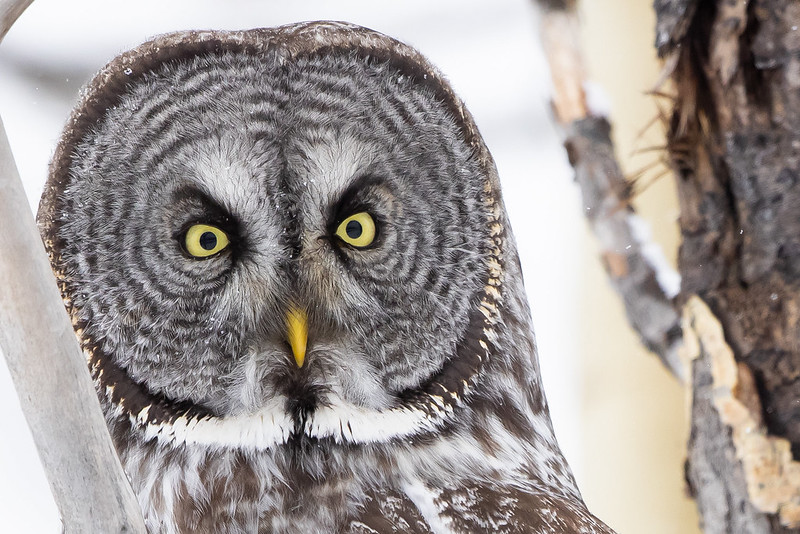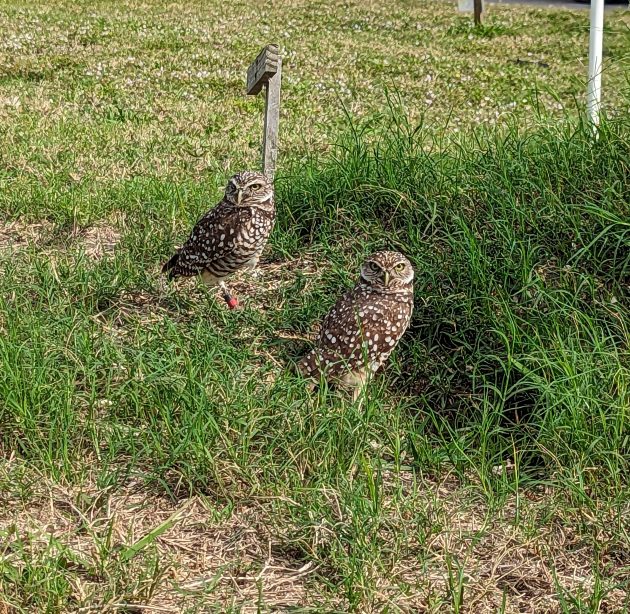
Owls are such mysterious creatures, most of them hunters of the night. They are the subjects of myth and superstition. Their cryptic markings and ability to blend into their habitats make them hard to see. Yet, once you find one, they seem to be everywhere. You have to be patient, quiet, non-threatening and willing to check out trees, holes, and fields. Today, I thought I would share some of my owling stories.
In the winter of 2005, there was an irruption of Great Grey Owls, searching for food. They showed up in Southern Ontario and in some northern US states. I heard they were being seen at a marsh east of Toronto, so my husband and I headed out there. When we arrived, we were told that some had been seen that day, but not lately. Another birder suggested we check out a different area of the marsh. We trudged through the deep snow, but had no luck. The other birder and my husband turned back, but I am stubborn when it comes to a lifer and a fabulous one at that. Suddenly, I heard Black-capped Chickadees going nuts. I followed their alarm calls to a clump of trees. I stopped and peered around a trunk. Calmly peering back at me was a Great Grey Owl! (See picture at top of blog.) It had heard my approach and was curious to know what was there. I backed up cautiously, turned and ran like a maniac to get the guys to see this magnificent bird. The other birder had a scope and we watched the owl from afar. We didn’t want to stress the owl and make it waste any more energy.

Northern Hawk Owl
Another rare visitor to Southern Ontario is the Northern Hawk Owl. I first saw this diurnal owl in the winter of 2007. A friend heard the bird was outside Toronto, hanging around farm fields, near a rail line. We all piled into our little car and headed out. We found the bird, being admired by a flock of birders. We saw it perched at the top of an evergreen, chattering away. It would fly off to hunt and then return to its perch, totally unbothered by all the spectators.

Snowy Owl (picture taken at Tommy Thompson Park in Toronto)
A more common visitor to Toronto and Southern Ontario is the Snowy Owl. This owl finds spots that look like the tundra, where it nests in the summer. They may be in farm fields, sitting on docks of marinas or on breakwaters on the lake (or even a jumble of discarded construction material). You need to scan these areas, looking for what looks like a dirty sack of flour. Many times, I think I have a Snowy, but it is a plastic bag or overturned, white pail. You know you have your owl when a pair of bright, yellow eyes glare back at you.

Burrowing Owls
Not all my owl adventures involve snow. In March 2009, in Arizona, I saw my lifer Burrowing Owl. I have seen these cute little owls, peeking out of their burrows, in Texas and Florida, too. In Naples Florida, they have a burrow on the edge of a schoolyard. This past winter, we were near that spot in the evening, when a Burrowing Owl landed on a fence near us. It looked around and chattered at us.

Barred Owl
Barred Owl are found in Southern Ontario, but I’ve had more interactions with them in SW Florida. In a Naples park, I’ve heard them making their “who cooks for you all” call. In that same park, I saw a pair perched together. Last year, at Audubon’s Corkscrew Swamp Sanctuary, there was a young Barred Owl perched on an air plant, which showed how light owls can be. People would walk by, look at it, do a double take, and then ask if it was real. This owl was just as fascinated with the people, moving its head all around for better looks.

Eastern Screech-Owl fledgling
One owl that is very common is the Eastern Screech-Owl. These small owls are easily overlooked as they hide in their roost holes and blend in with the surrounding trees’ surfaces. There is a park in Toronto where we often see these owls. In the late winter / early spring, we find the adults hiding in evergreens. Later, we will see them active at a nest hole. Then, in late spring, we’ll see their young. One year, there were five owlets who had fledged from the nest hole. They looked like lumps of dryer lint with eyes. It was exciting to observe them moving along the branches and making their begging calls for food.
Finding an owl in the wild is a precious gift from nature. If we give them the care and respect they deserve, others will get to enjoy them for years to come.
Note: Picture of Burrowing Owls by Leslie Kinrys. All other photos are from Wikipedia Commons, an online source of copyright-free photos.













A sentence like “A more common visitor to Toronto and Southern Ontario is the Snowy Owl” makes my heart skip a beat. But then I realise the seasonal character of those visits. Not the summer, is it?
Sorry, Peter. I should have said a common winter visitor.